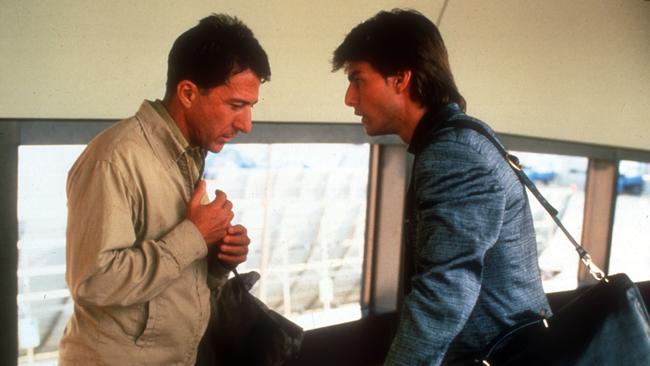Celebrating a myth: Rain Man was marketing gold for Qantas
Qantas hit the jackpot when Dustin Hoffman perpetuated an urban myth in the movie Rain Man.

Qantas can thank Rain Man for one of its most enduring myths — that it has never lost a passenger in an air crash.
In the 1988 movie, the autistic Ray (Dustin Hoffman) refuses to get on a plane from Cincinnati to Los Angeles with brother Charlie (Tom Cruise). After rejecting American Airlines, Continental and Delta by reciting details of their most recent crashes, Charlie insists: “All airlines have crashed at one time or another — it doesn’t mean they’re not safe.”
Ray: “Qantas.”
Charlie: “Qantas?”
Ray: “Qantas never crashed.”
Charlie was right to point out that in order to fly Qantas to Los Angeles the pair would have to first get to Melbourne (or Sydney or Brisbane), but he could have saved his breath. They drove, thus setting up the story for the rest of the movie.
The scene was gold for Qantas. It alone among leading international airlines allowed the pivotal sequence that justified the rest of the film to run on its in-flight movie systems.
All others edited it out, leaving viewers perplexed. The scene was used during the 1989 Academy Awards when Rain Man won four Oscars, including for Dustin Hoffman as best actor.
But Ray’s claim that Qantas had never crashed was wrong. As Jim Eames records in his story of Qantas at war, the airline lost more than half its fleet in 1942 and 1943, along with a total of 72 passengers and crew.
At the outbreak of the war Qantas was flying its Empire flying boats to Karachi, in what is now Pakistan, to link up with the British flag carrier BOAC, which carried its passengers to London.
But when Singapore fell to the Japanese on February 15, 1942 and Darwin was bombed four days later, the Kangaroo route was shattered. Qantas beat a hasty retreat via what was then the Dutch East Indies.
The first loss came on January 30, 1942 when the flying boat Corio, en route to Kupang in western Timor, was downed by seven Japanese Zero fighters, with the loss of 13 lives.
The next month, February 1942, brought disaster on two fronts. Qantas escaped the first Japanese bombing raid on Darwin on February 19, 1942 with only minor damage but days later its DH-86 flight from Brisbane to Cloncurry, via Roma and Charleville, spun out of the clouds and crashed near Belmont, 20km west of the airport, with the loss of nine lives.
Days later the flying boat Circe was heading to the small coastal town of Tjilatjap in Java to pick up stranded diplomats, service personnel and airline staff when it disappeared without trace 320km from its destination, with the loss of 16 passengers and four crew.
A week later two boats, the Corinna and Centaurus, were sunk at their moorings during a Japanese bombing raid on Broome, and another flying boat, the Corinthian, was lost in a Japanese raid on Darwin three weeks later along with two crew.
Qantas went another year without loss before incidents near Port Moresby in April and November 1943 claimed two more aircraft and 27 lives. Qantas’s first fatal crash was near Tambo in central Queensland in 1927, that cost three lives. It’s last was a Drover aircraft that crashed in PNG’s Highlands in 1951.
Qantas can certainly claim it has never lost a passenger in peacetime. Or in the jet age. But the urban myth that it has never crashed or never lost a passenger is just that: a myth.




To join the conversation, please log in. Don't have an account? Register
Join the conversation, you are commenting as Logout